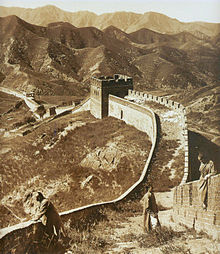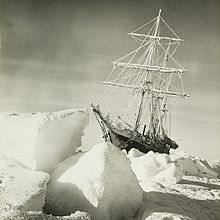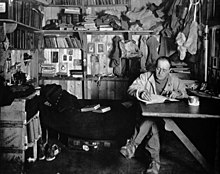Herbert Ponting

Herbert George Ponting (born March 21, 1870 in Salisbury , † February 7, 1935 in London ) was an English photographer . He became known as an expedition photographer and cameraman on Robert Falcon Scott's Terra Nova expedition to the Ross Sea and the South Pole (1910–1913). In this role he took some of the most famous photos from the early days of modern Antarctic exploration.
Early life: Before the Terra Nova expedition
Ponting was born in Salisbury in the south of England in 1870 . He was drawn to the stories of the Wild West early on ; in the 1890s he worked in the mining industry and bought an orchard in California . After the project with the court had failed, Ponting began freelance photography relatively late in life, namely not until 1900. Improvements in the printing press made it possible for many mass-produced newspapers to publish and print photographic illustrations for the first time. Ponting has sold his work in four of the leading London magazines, namely Graphic , Illustrated London News , Pearson's and Strand Magazine . In the beach appeared Ponting images in addition to the Sherlock Holmes stories by Arthur Conan Doyle .
In 1910, Ponting published a book called In the Lotos Land, Japan . His flair for journalism and his ability to develop his photographs into a narrative led to his acceptance as a photographer on board the Terra Nova .
The Terra Nova and the Antarctic
As a member of the "Coast Group" in early 1911, Ponting helped set up the winter camp for the Terra Nova Expedition at Cape Evans on Ross Island . There was also a simple darkroom in the warehouse . Although the expedition took place over 20 years after the invention of photographic film , Ponting preferred high quality photos taken on glass plates.
Ponting was one of the first men to use a portable film camera in Antarctica . The primitive device called Cinématographe could record short sequences. Ponting also used the autochrome process in Antarctica , the resulting autochromes are the first color photographs of the continent. The expedition scientists studied the behavior of large Antarctic animals, especially killer whales , seals and penguins . Ponting tried to get as close as possible to these animals, both on the Terra Nova in the pack ice and later on Ross Island. In early 1911 he narrowly escaped death when a school of eight killer whales almost pushed him and his photographic equipment off an ice floe into McMurdo Sound .
In the Antarctic winter of 1911, Ponting took many flash photographs of Scott and other team members in the cabin at Cape Evans. With the beginning of the time suitable for sleigh rides in 1911/12, Ponting's field work began to come to an end. Since he was no longer the youngest, he was not expected to help with the establishment of depots south on and across the Ross Ice Shelf . Ponting photographed the other members of the coastal group setting out on the south polar voyage, the success of which was widely expected. He left Antarctica on the Terra Nova in March 1912 and returned to England to organize his stock of over 1700 photo plates and to publish a report on the expedition. Ponting's illustrated adventure report was to be used by Scott in 1913 for lectures and fundraising.
After the Terra Nova expedition
The disastrous end of "Scott's Last Expedition" also affected Ponting's later life and career. When the Terra Nova sailed south in 1910, he had left behind large debts. It was expected that Scott would return from the pole as a celebrity and that he could use moving images from his expedition in reports. Ponting's film sequences, backed by illuminated glass plates, would have been a key element in the financial repayment of the expedition.
When a search party found the bodies of Scott and his companions in a tent on the Ross Ice Shelf in November 1912 , they also discovered the diaries and letters of the deceased. These records described the final days of the South Pole Group as they suffered from exhaustion and malnutrition , the deaths of Edgar Evans and Lawrence Oates, and how a day-long blizzard thwarted their attempt to get to the food depot 11 miles away. Aware of their hopeless situation, Scott used the time he had left to ask his compatriots to take care of the bereaved in an emotional “message to the public”.
This appeal did not fail to have its effect. The resulting monetary donations covered the entire cost of the expedition and enabled the families of the survivors to make a living. Ponting's photographic work served to illustrate the book Scott's Last Voyage published in 1914 , which is essentially based on the diary entries of the expedition leader.
After the end of the First World War, Ponting published his own memories of the expedition in 1921 under the title The Great White South and spoke the explanatory commentary in the film Ninety degrees South (1933), which was based on the film sequences he shot during the expedition. He also gave a number of lectures on Antarctica. However, this work brought him little income, and another photographic work was not very successful. Ponting died in London in 1935.
influence
The British mountaineer, photographer and filmmaker John Noel is one of the people who were significantly influenced by Herbert Posting's work. John Noel accompanied the British Mount Everest Expedition of 1922, which had to be canceled after three unsuccessful attempts to climb Mount Everest , as a photographer and filmmaker. Noel is best known today for his film The Epic of Everest, about the British Mount Everest Expedition of 1924 that ended with the deaths of George Mallory and Andrew Irvine . Together with the film Climbing Mount Everest (1922), Noel shaped the cinematic portrayal of mountaineering as a heroic struggle with this documentary. He was instrumental in making George Mallory a British national hero.
Influenced by the approach taken by the Italian mountain photographer Vittorio Sella and Herbert Ponting, Noel made extensive adjustments to his equipment in order to be able to photograph and film under the specific expedition conditions. This included a tent that could be used as a darkroom and a specially developed stove for drying the negatives that could be fired with yak dung . The film camera was based on the model that Ponting had used in Antarctica . Like the camera used by Ponting, it was very light and, among other things, had a protective rubber cover to prevent his face from freezing to the camera. Before leaving, Noel watched 16 times the film The Great White South , which Posting made about Scott's Antarctic expedition.
Photographic heritage
The Scott Polar Research Institute bought the Ponting collection for £ 533,000 in 2004 . Also, one of Ponting's darkrooms is in the collection at Ferrymead Heritage Park in Christchurch , New Zealand .
gallery
Photographs from Asia
More photographs of the Terra Nova expedition
exhibition
- 2010: The conquest of the South Pole - photographs by Herbert Ponting , Flo Peters Gallery, Chilehaus C, Pumpen 8, Hamburg
Others
Ponting is the namesake for the Ponting cliff in East Antarctic Victoria Land.
He is also the author of the humorous poem The Sleeping Bag :
On the outside grows the furside. On the inside grows the skinside.
So the furside is the outside and the skinside is the inside.
As the skinside is the inside (and the furside is the outside)
One 'side' likes the skinside inside and the furside on the outside.
Others like the skinside outside and the furside on the inside
As the skinside is the hard side and the furside is the soft side.
If you turn the skinside outside, thinking you will side with that 'side',
then the soft side furside's inside, which some argue is the wrong side.
If you turn the furside outside - as you say, it grows on that side,
then your outside's next the skinside, which for comfort's not the right side.
For the skinside is the cold side and your outside's not your warm side
and the two cold sides coming side-by-side are not the right sides one 'side' decides.
If you decide to side with that 'side', turn the outside furside inside
Then the hard side, cold side, skinside's, beyond all question, inside outside.
Web links
Individual evidence
- ^ Wade Davis: Into the Silence , p. 382.
- ^ Wade Davis: Into the Silence , p. 384.
- ^ A b Wade Davis: Into the Silence , p. 383.
| personal data | |
|---|---|
| SURNAME | Ponting, Herbert |
| ALTERNATIVE NAMES | Ponting, Herbert George (full name) |
| BRIEF DESCRIPTION | English photographer |
| DATE OF BIRTH | March 21, 1870 |
| PLACE OF BIRTH | Salisbury |
| DATE OF DEATH | February 7, 1935 |
| Place of death | London |













